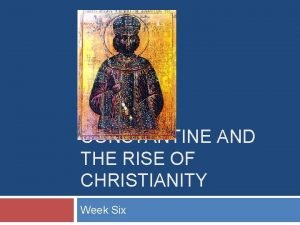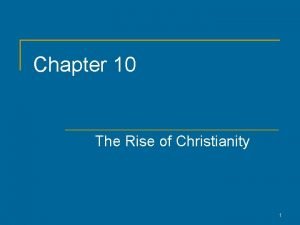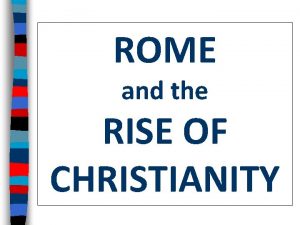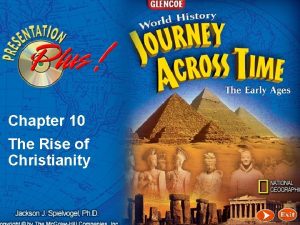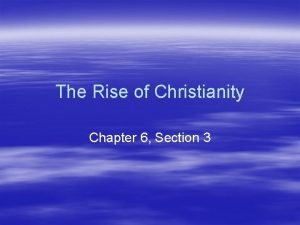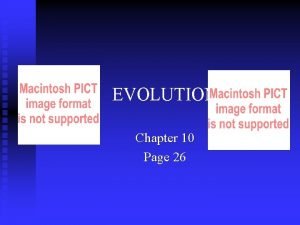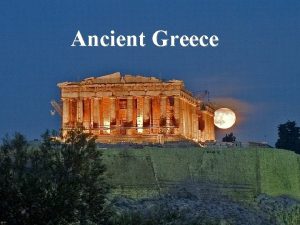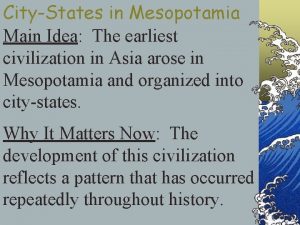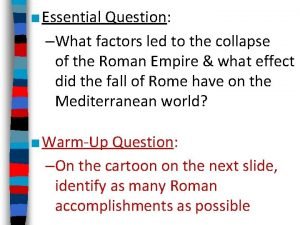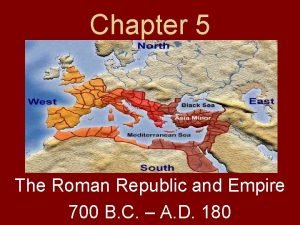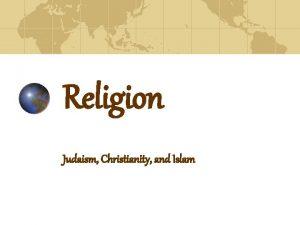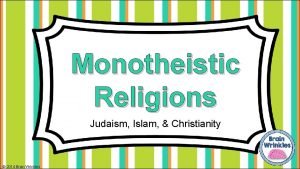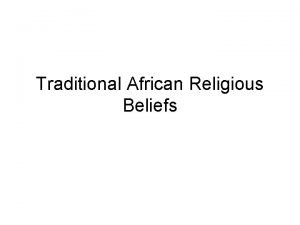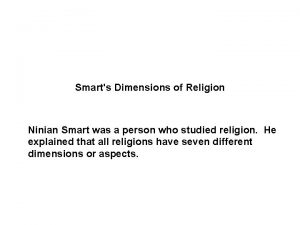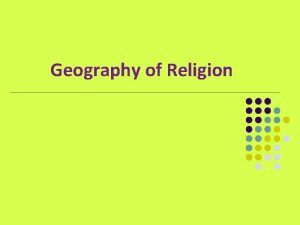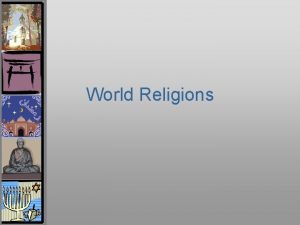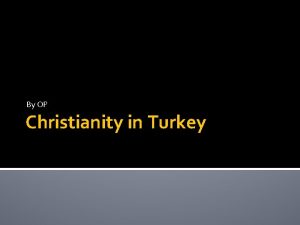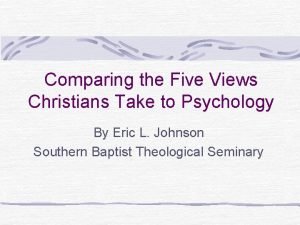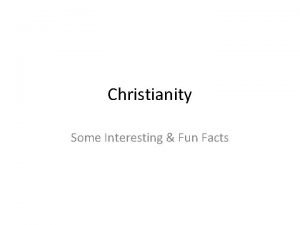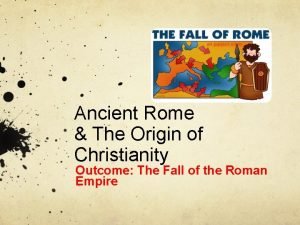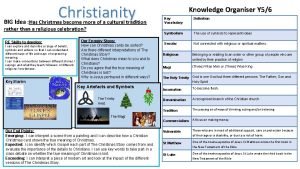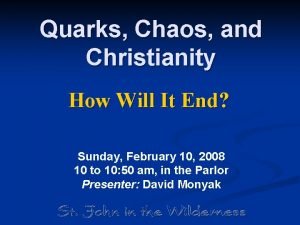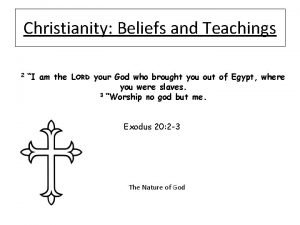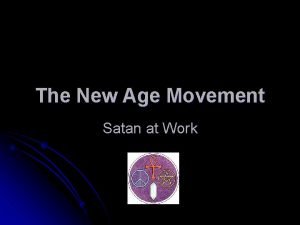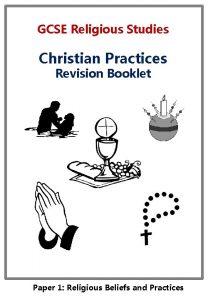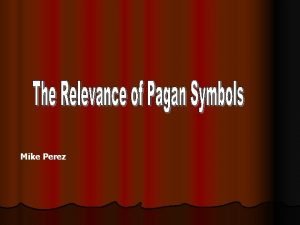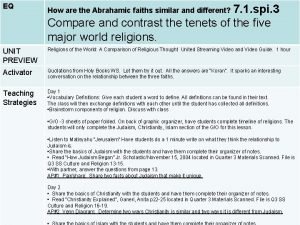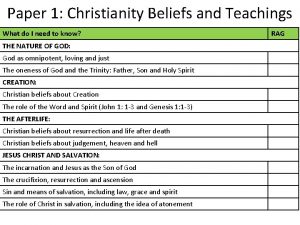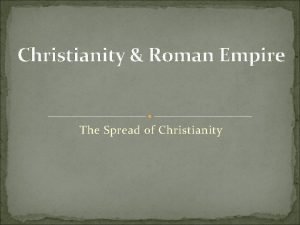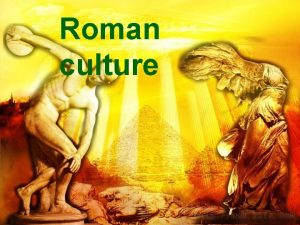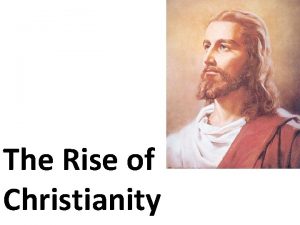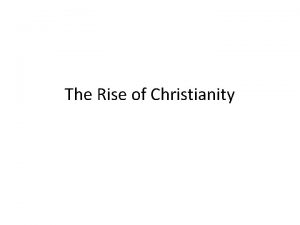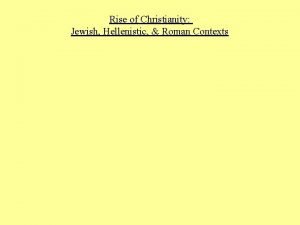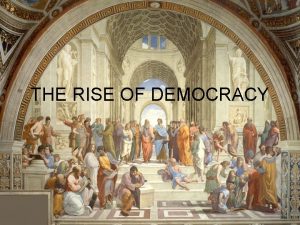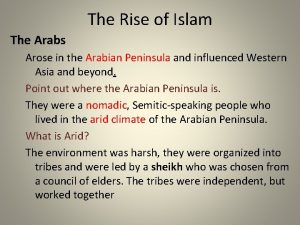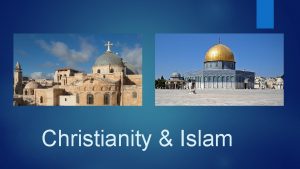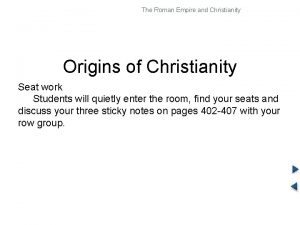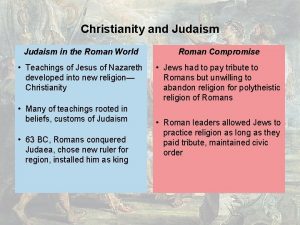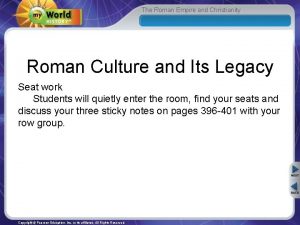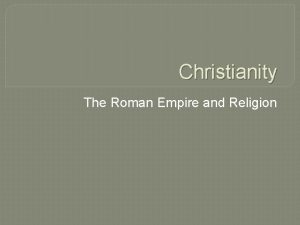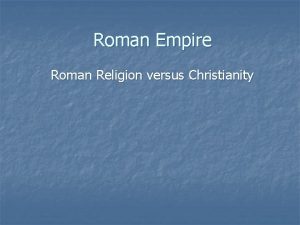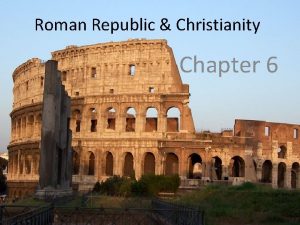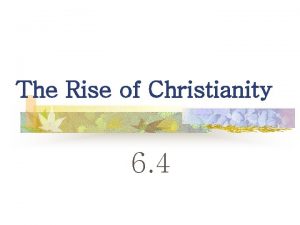Rise of Christianity Christianity arose in the Roman















































































- Slides: 79

Rise of Christianity • Christianity arose in the Roman Empire, and spread throughout the Empire as the Empire was in decline • The rise of Christianity marks the historical transition between the Roman Empire and the Medieval period • This period is called late antiquity: 284 -610 C. E.

Who was Jesus? • A Jew born in Palestine (Judea) during the reign of King Herod • Jesus “of Nazareth” was born in Bethlehem (where Joseph went for the census) • Actually, his name was Joshua (Jesus is his name in Greek; and Christ is a name added by St. Paul, Greek translation of Hebrew Messiah, meaning “anointed one”)




Who was Jesus? • In his early 30 s he became a public preacher and caused hostility and suspicion both among the Jews and among the Roman authorities. • He was crucified in 33 C. E. for subversion, under authority of Roman governor Pontius Pilate.



Greco-Roman Background • Roman religion was eclectic: adopted gods from Greece, tolerated other religions • No concept of eternal life or damnation based on ethical behavior • Hellenistic philosophies, however, offered alternative ideas: – Stoicism: equality of people – Neoplatonism (Plotinus): eternal soul ascends toward purification

Greco-Roman Background • Roman Empire absorbed Eastern idea of emperor as a god: Empire became theocratic • At the same time, discontented citizens of Empire looked to the East for alternative, mystical religion

Near-Eastern Background • Mystery Cults, e. g. , Isis (Egypt); Dionysus (Greece); Mithra (Persia) – Celebrated seasonal change and rebirth – Celebrated rituals of spiritual death and rebirth: baptism; eating flesh and blood of deity in a communal meal – Were tolerated by Rome so long as Romans continued to honor the Roman gods and emperors

Roman Mystery Rites, Pompeii, c. 50 C. E.

Mithraism • Most popular mystery cult, worshipped ancient god-hero Mithra • Mithra’s slaughter of Sacred Bull believed to make the earth fertile • Believed in eternal life • Rituals: baptism; meal of bread and wine • Male religion: No women at rites

Mithraism • Mithra’s birth celebrated on December 25 • At first, Romans considered Christianity an imitation of Mithraism • Christians considered Mithraism a parody of Christianity

Jewish Background: Review 1. Period of Patriarchs • after 2000 BCE : Abraham: covenant: “I will be your God; you will be my people” • Chosen People • Abraham, Isaac, Jacob (aka “Israel=“soldier of God”)

2. Period of Exodus • After 1700 BCE: into Egypt, where they are enslaved • C. 1300 BCE Moses leads out of Egypt to Canaan, but Canaan is occupied

3. Period of Conquest • Battles for the land of Canaan recorded in the books of Joshua and Judges

4. United Monarchy • Samuel, Saul (first king), and David battle the Canaanites; David conquers them (King David was the ancestor of Joseph, “father” of Jesus, husband of Mary) • 960 -920 BCE—Solomon establishes Jerusalem, builds a temple for the Ark of the Covenant (50)


5. Divided Kingdom and Exile • Israel divided North and South – North: Israel – South: Judah • Nebuchadnezzar invades Jerusalem, takes Hebrews (Jews) into captivity in Babylon (586 -538 BCE) • Book of Job probably written during this time


6. Return from Captivity • 538 BCE: return from captivity • Jews later ruled by Persians, Greeks, and— after a short independence— • In 63 B. C. E. Rome captured the Jewish homeland of Jerusalem and surroundings— became the province of Judea • 70 CE: Rome destroys Jerusalem, including the temple

Jewish Background • Unlike the mystery cults, Judaism was monotheistic and did not allow the worship of Roman gods and emperors • Rome destroyed Jerusalem in 70 C. E. while repressing a Jewish revolt

Jewish Background • At the time of Christ, there was much controversy among rabbis (Jewish religious teachers) regarding the Messiah (“Anointed One”) – Sadducees envisioned political leader who would overthrow the Romans; they did not believe in eternal reward or punishment – Pharisees did believe in eternal life; their Messiah would lead good people to salvation

Jewish Background • Another Jewish group was called the Essenes – Practiced asceticism and sought liberation of the immortal soul from the body – believed in a leader who would come at the end of time • All these groups were awaiting the appearance of a great spiritual teacher

Dura-Europos • In present-day Syria; destroyed by Persians in 256; covered with sand uncovered in 1930 s • Discovery of – – Christian church temple to Zeus Mithraism meeting place, and Jewish synagogue shows that these religions could coexist peacefully

Christian House Church, Dura-Europos

Christ Walking on Water, Dura-Europos

Synagogue, Dura-Europos

Mithra Fresco, Dura-Europos

Temple of Zeus, Dura-Europos

Jesus • We know about Jesus through the Gospels (“good news”) of Matthew, Mark, Luke, and John. These were Greek texts and the first (Mark) was not written until about 40 years after Christ’s death. • All that Christ says in the Gospels can be repeated in about 2 hours

The Good Shepherd, c. 300 C. E.

Christ’s Teachings • Challenged the materialism and power of the Roman world, at a time of increasing gap between rich and poor – “How blessed are the poor in spirit: the kingdom of Heaven is theirs” (Matthew 5: 3) – “Blessed are the gentle: they shall have the earth as inheritance” (Matthew 5: 4) – “Do not store up treasure for yourselves on earth” (Matthew 6: 19)

Christ’s Teachings • Challenged traditional Judaism – Emphasized spirit rather than letter of law, moral intention rather than outward behavior (“when you pray, go to your private room” [Matthew 6: 6]) – Characterized God as compassionate and loving rather than punishing – Emphasized eternal life: the kingdom of Heaven

Christ’s Teachings • Challenged people with a higher standard of morality, defying common sense – “love your enemies and pray for those who persecute you” (Matthew 5: 44) – “if anyone hits you on the right cheek, offer him the other as well (Matthew 5: 39)

The Ministry of Paul • Saul of Tarsus (about 10 -65 C. E. ) • A tentmaker, he was a persecutor of Christians and then he became a Christian, changing his name to Paul • Paul was a busybody before his conversion, and a busybody after his conversion: his beliefs changed, but his personality did not


Caravaggio, The Conversion on the Way to Damascus, 1600



Paul’s letters • • Romans I Corinthians II Corinthians Galatians Ephesians Philippians Colossians • • • I Thessalonians I Timothy II Timothy Titus Philemon


I Corinthians 13: 1 -13 1: If I speak in the tongues of men and of angels, but have not love, I am a noisy gong or a clanging cymbal. 2: And if I have prophetic powers, and understand all mysteries and all knowledge, and if I have all faith, so as to remove mountains, but have not love, I am nothing. 3: If I give away all I have, and if I deliver my body to be burned, but have not love, I gain nothing.

4: Love is patient and kind; love is not jealous or boastful; 5: it is not arrogant or rude. Love does not insist on its own way; it is not irritable or resentful; 6: it does not rejoice at wrong, but rejoices in the right. 7: Love bears all things, believes all things, hopes all things, endures all things.

8: Love never ends; as for prophecies, they will pass away; as for tongues, they will cease; as for knowledge, it will pass away. 9: For our knowledge is imperfect and our prophecy is imperfect; 10: but when the perfect comes, the imperfect will pass away.

11: When I was a child, I spoke like a child, I thought like a child, I reasoned like a child; when I became a man, I gave up childish ways. 12: For now we see in a mirror dimly, but then face to face. Now I know in part; then I shall understand fully, even as I have been fully understood. 13: So faith, hope, love abide, these three; but the greatest of these is love.

Paul’s contributions 1. Proclaimed Christianity to be a universal religion, not just for Jews. He was “Apostle to the Gentiles” 2. Supported idea of Jesus as Christos (Gr. “Annointed One”; “Messiah”), the God/man who died for man’s sins: Jesus’ death an act of atonement. Jesus as New Adam (see Fiero 185). 3. Salvation through faith, not Jewish law

Crucifixion, Santa Sabina, Rome, c. 430 C. E.

Christianity in Roman Empire • At first, Christians were persecuted because they refused to worship the Roman gods and they refused to serve in the Roman army. • Persecution was horrific but not very widespread. It brought publicity to the Church and won converts by showing the strength of Christians’ faith.

Christianity in Roman Empire • 312: Emperor Constantine converted to Christianity • 313: Edict of Milan ends persecution of Christians • By end of 4 th century, Theodosius the Great prohibited paganism of any kind

Why did Christianity prevail? • Theological Factors • Social Factors

Theological Factors • • New and exclusive Explained the existence of evil Offered a view of salvation Salvation equally for men and women

Theological Factors • Free of bothersome regulations (compared to Judaism) and big rituals (compared to mystery cults) • Historically credible: Jesus was an actual person who set an example of how to live

The Good Shepherd, c. 425 -50 C. E. , Ravenna, Italy

Social Factors • Easy to spread: Empire had good roads, common language • Gap between rich and poor meant that the poor were looking for comfort • Paul wrote that in this religion there is “neither Jew nor Gentile; male nor female; slave or free person. ”

Social Factors • Threat of Germanic tribes created a sense of social insecurity • As the Empire declined, the Church provided an alternative authority (priests) and an alternative source of social services: caring for the sick, burying the dead, etc.

Seated Buddha, c. 200 C. E. , Pakistan

Who was Buddha? • Buddha (“Enlightened One”) was a man, not a god: his name was Siddhartha Gautama (about 500 B. C. E. ) • He was a Hindu. Buddhism developed out of Hinduism, as Christianity developed out of Judaism • Siddhartha tried marriage and asceticism before discovering meditation as his vocation

What did Buddha teach? • The goal of life is to reach nirvana—a state of enlightenment and release from reincarnation • Buddha rejected the strict caste system and the 330 million gods of Hinduism • Instead, he focused on personal enlightenment

Four Noble Truths • • Pain is universal (Life is suffering) Desire causes pain Ceasing to desire relieves pain The Eightfold Path leads to release of pain – Right views, right intention, right speech, right action, right livelihood, right effort, right mindfulness, right concentration

Buddhism and the Self • Enlightenment involves extinguishing the Self • What we call self is a combination of five skandhas—body, feelings, perceptions, disposition, consciousness—which change from moment to moment

Buddhism and the Self • In Buddhism, properly speaking, there is no soul, because the soul would be unchanging • Buddha believed that you could become free of karma; Hinduism believes that karma stays with you

Buddhism and other religions • Buddhism does not reject the truths of other religions, and has supplemented other religions in China and Japan • However, originally Buddhism sought to get beyond the attachment to gods altogether


The Wheel of Law (Dharmachakra)

Dharma with Deer

The Spread of Buddhism • Emperor Asoka (3 rd century B. C. E. ) made Buddhism the state religion of India and sent missionaries as far as Greece to the West and Ceylon to the Southeast • By first century C. E. two major sects of Buddhism had emerged: Hinayana (Theravada) and Mahayana • Ultimately Buddhism did not stick in India: the Brahmin caste resisted its egalitarianism

Hinayana (Theravada) Buddhism (“Little Raft”) • Spread from India to Southeast Asia: Ceylon (Sri Lanka), Burma (Myanmar), Cambodia, Laos, Thailand • Emphasizes role of monks and monasteries: monks seek Enlightenment and society supports them (Hindu influence: priestly caste)

Hinayana (Theravada) Buddhism (“Little Raft”) • Men can become monks permanently or temporarily: in Thailand Myanmar, every male spends some time in monastery • Centrality of monastery leads to complex philosophy

Mahayana Buddhism (“Big Raft”) • Spread from India north and east to China, Tibet, and Japan, beyond Hindu cultures and social structures • Taught that Buddha is a divinity • Strongly emphasized bodhisattvas, “Buddhas-to-be” who stayed back from enlightenment to help others along the way. E. g. , Guanyin—goddess of mercy

Standing Bodhisattva, late 2 nd century C. E. , Pakistan

Guanyin China, Northern Zhou or early Sui dynasty, about 580 A. D

Mahayana Buddhism (“Big Raft”) • Chinese Buddhism believed in an actual heaven, “The Pure Land of the West, ” instead of the abstract notion of nirvana • Another sect, Chan or Zen, focused on meditation

Theravada vs. Mahayana • • Individual Self-effort Wisdom Monks Buddha a saint Anti-ritual Meditation Conservative • • Society Grace Compassion Laymen Buddha a savior Pro-ritual Supplication Liberal

Christianity vs. Buddhism • Similarities – Both spread through, respectively, the Roman world and Asia, in the early centuries of C. E. – Christianity developed from an older religion, Judaism, and Buddhism developed from Hinduism – Both religions provided consolation to people in periods of imperial instability: in Roman Empire and in Han Empire

Christianity vs. Buddhism • Similarities – Both emphasized equality in face of hierarchical cultures – Both emphasized mysticism in face of rationalist and materialist traditions

Christianity vs. Buddhism • Differences – Christianity emphasizes human sinfulness; Buddhism does not – Christianity emphasizes the identity of God; Buddhism emphasizes the path to enlightenment

Christianity vs. Buddhism • Differences – Christianity emphasizes communal ritual, dogma, hierarchy; – Buddhism emphasizes private meditation, monastic instruction, decentralized authority
 Constantine rise of christianity
Constantine rise of christianity Chapter 10 the rise of christianity
Chapter 10 the rise of christianity Rome and the rise of christianity
Rome and the rise of christianity Chapter 10 the rise of christianity
Chapter 10 the rise of christianity The rise of christianity chapter 6 section 3
The rise of christianity chapter 6 section 3 A union b example
A union b example Rise and rise again
Rise and rise again Tricky dicky richard nixon
Tricky dicky richard nixon Rise again and again until lambs
Rise again and again until lambs As darwin studied fossils what new questions arose
As darwin studied fossils what new questions arose Tyranny in the greek polis arose as
Tyranny in the greek polis arose as The earliest civilization in asia arose in
The earliest civilization in asia arose in Christ arose
Christ arose What factors led to the rise of the roman empire
What factors led to the rise of the roman empire Roman republic vs roman empire
Roman republic vs roman empire Roman republic vs roman empire
Roman republic vs roman empire Tư thế ngồi viết
Tư thế ngồi viết Thứ tự các dấu thăng giáng ở hóa biểu
Thứ tự các dấu thăng giáng ở hóa biểu Phép trừ bù
Phép trừ bù Thể thơ truyền thống
Thể thơ truyền thống Hát lên người ơi
Hát lên người ơi Hổ sinh sản vào mùa nào
Hổ sinh sản vào mùa nào đại từ thay thế
đại từ thay thế Diễn thế sinh thái là
Diễn thế sinh thái là Vẽ hình chiếu vuông góc của vật thể sau
Vẽ hình chiếu vuông góc của vật thể sau Cong thức tính động năng
Cong thức tính động năng Tỉ lệ cơ thể trẻ em
Tỉ lệ cơ thể trẻ em Thế nào là mạng điện lắp đặt kiểu nổi
Thế nào là mạng điện lắp đặt kiểu nổi Lời thề hippocrates
Lời thề hippocrates Vẽ hình chiếu đứng bằng cạnh của vật thể
Vẽ hình chiếu đứng bằng cạnh của vật thể Quá trình desamine hóa có thể tạo ra
Quá trình desamine hóa có thể tạo ra Các môn thể thao bắt đầu bằng tiếng chạy
Các môn thể thao bắt đầu bằng tiếng chạy Hình ảnh bộ gõ cơ thể búng tay
Hình ảnh bộ gõ cơ thể búng tay Sự nuôi và dạy con của hổ
Sự nuôi và dạy con của hổ điện thế nghỉ
điện thế nghỉ Dạng đột biến một nhiễm là
Dạng đột biến một nhiễm là Nguyên nhân của sự mỏi cơ sinh 8
Nguyên nhân của sự mỏi cơ sinh 8 Trời xanh đây là của chúng ta thể thơ
Trời xanh đây là của chúng ta thể thơ độ dài liên kết
độ dài liên kết Chó sói
Chó sói Thiếu nhi thế giới liên hoan
Thiếu nhi thế giới liên hoan Fecboak
Fecboak Một số thể thơ truyền thống
Một số thể thơ truyền thống Thế nào là hệ số cao nhất
Thế nào là hệ số cao nhất Sơ đồ cơ thể người
Sơ đồ cơ thể người Frameset trong html5
Frameset trong html5 Các số nguyên tố là gì
Các số nguyên tố là gì đặc điểm cơ thể của người tối cổ
đặc điểm cơ thể của người tối cổ Cách giải mật thư tọa độ
Cách giải mật thư tọa độ Các châu lục và đại dương trên thế giới
Các châu lục và đại dương trên thế giới Glasgow thang điểm
Glasgow thang điểm ưu thế lai là gì
ưu thế lai là gì Thẻ vin
Thẻ vin Tư thế ngồi viết
Tư thế ngồi viết Cái miệng bé xinh thế chỉ nói điều hay thôi
Cái miệng bé xinh thế chỉ nói điều hay thôi Các châu lục và đại dương trên thế giới
Các châu lục và đại dương trên thế giới Từ ngữ thể hiện lòng nhân hậu
Từ ngữ thể hiện lòng nhân hậu Bổ thể
Bổ thể Christianity
Christianity Christianity and confucianism venn diagram
Christianity and confucianism venn diagram East african religion
East african religion Ninian smart dimensions
Ninian smart dimensions Monotheism chart judaism christianity islam
Monotheism chart judaism christianity islam Islam hearth
Islam hearth Christianity universalizing or ethnic
Christianity universalizing or ethnic History of christianity in turkey
History of christianity in turkey Psychology and christianity: five views
Psychology and christianity: five views Christianity interesting facts
Christianity interesting facts Ancient rome and the origins of christianity
Ancient rome and the origins of christianity Theravada buddhism beliefs
Theravada buddhism beliefs Christianity big ideas
Christianity big ideas Unit 7 lesson 4 medians and altitudes
Unit 7 lesson 4 medians and altitudes Christianity division chart
Christianity division chart Big crunch
Big crunch Christianity beliefs
Christianity beliefs New age satan
New age satan Evangelical worship gcse
Evangelical worship gcse Cross symbol
Cross symbol Judaism vs christianity chart
Judaism vs christianity chart Christianity beliefs
Christianity beliefs
